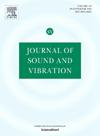Overflow elastic metasurfaces for underwater high-pressure-resistant acoustic wavefront control
IF 4.3
2区 工程技术
Q1 ACOUSTICS
引用次数: 0
Abstract
Elastic metasurfaces have shown strong ability of controlling the phase, amplitude and polarization of elastic waves on demand. However, limited by the porous-solid, bi-phase-solid and multi-phase-solid microstructural models, the existing elastic metasurfaces have to comprise some thin connecting rods or materials with low elastic modulus so that the transmutative modes can be induced to capture the required phase and amplitude manipulation. More strikingly, these microstructure features may result in the very low strength of reported elastic metasurfaces, let alone the ability to withstand high hydrostatic-pressure. To simultaneously maintain the abundant elastic wave modes of solids and stable complex wavefront control under high pressures, we propose a kind of overflow elastic microstructural model which comprises the internal acoustic-structure coupling and develop an inverse-design methodology of an overflow elastic metasurface for the pressure-insusceptibility underwater acoustic vortex. Firstly, a model regarding topology optimization of microstructures with internal acoustic-structure coupling is built to achieve the prescribed transmissive phases and amplitudes. Specifically, four kinds of topology-optimized overflow microstructures can simultaneously possess the stable phase difference covering 0-2π and high transmission above 0.9 within the frequency range of 15-15.9 kHz. Benefiting from the strong internal acoustic-structure coupling, the microstructures are discovered to support the monopole/dipole resonances in fluid domains and acoustic-induced local vibrations in solid parts, which leads to the customized nonlinear dispersion properties. Finally, the assembled overflow elastic metasurface is numerically and experimentally demonstrated to enable a focused acoustic vortex beam with the high orbital angular momentum (OAM) purity (close to 100%) and high energy-converting efficiency (over 80%) while keeping the high hydrostatic-pressure-resistant capacity. The proposed overflow microstructural model and inverse-design methodology of the overflow elastic metasurface are promising in constructing extreme elastic wave modes, and even developing new-generation flexible acoustic vortex beams for the large-capacity communication in the deep-water environment.
水下抗高压声波前控制的溢流弹性超表面
弹性超表面对弹性波的相位、振幅和极化具有较强的控制能力。然而,受多孔固体、双相固体和多相固体微观结构模型的限制,现有的弹性超表面必须包含一些低弹性模量的薄连杆或材料,以便诱导变形模式来捕获所需的相位和振幅操纵。更引人注目的是,这些微观结构特征可能导致所报道的弹性超表面的强度非常低,更不用说承受高静水压力的能力了。为了在高压条件下保持固体丰富的弹性波模态和稳定的复杂波前控制,提出了一种包含内部声-结构耦合的溢流弹性微结构模型,并提出了一种压力不敏感水声涡的溢流弹性超表面反设计方法。首先,建立了具有内声-结构耦合的微结构拓扑优化模型,以实现规定的传输相位和振幅;具体而言,四种拓扑优化的溢流微结构在15-15.9 kHz频率范围内同时具有覆盖0-2π的稳定相位差和高于0.9的高传输率。得益于强大的内部声-结构耦合,发现微观结构支持流体域的单极子/偶极子共振和固体部件的声诱导局部振动,从而导致定制的非线性色散特性。最后,通过数值和实验验证了该组合溢流弹性超表面能够实现高轨道角动量(OAM)纯度(接近100%)和高能量转换效率(超过80%)的聚焦声涡束,同时保持高的静水耐压能力。所提出的溢流微结构模型和溢流弹性超表面反设计方法,对于构建极端弹性波模,甚至开发新一代柔性声涡旋波束,实现深水环境下大容量通信具有重要意义。
本文章由计算机程序翻译,如有差异,请以英文原文为准。
求助全文
约1分钟内获得全文
求助全文
来源期刊

Journal of Sound and Vibration
工程技术-工程:机械
CiteScore
9.10
自引率
10.60%
发文量
551
审稿时长
69 days
期刊介绍:
The Journal of Sound and Vibration (JSV) is an independent journal devoted to the prompt publication of original papers, both theoretical and experimental, that provide new information on any aspect of sound or vibration. There is an emphasis on fundamental work that has potential for practical application.
JSV was founded and operates on the premise that the subject of sound and vibration requires a journal that publishes papers of a high technical standard across the various subdisciplines, thus facilitating awareness of techniques and discoveries in one area that may be applicable in others.
 求助内容:
求助内容: 应助结果提醒方式:
应助结果提醒方式:


